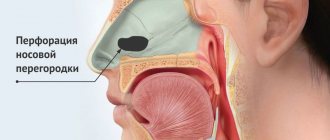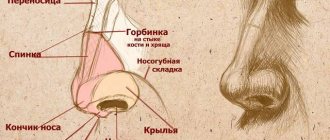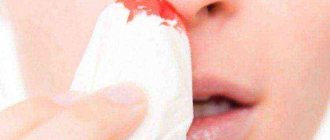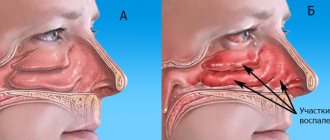The ICD code is J34.2 (deviated or displaced nasal septum).
A common pathology that can cause complications depending on the degree of complexity of the deviation from the normal position of the nasal septum.
The nasal septum is a thin plate that consists of 2 types of tissue: cartilage and bone. Divides the inhaled air flow into two parts for uniform flow. Also, flow separation allows you to quickly warm the inhaled air, humidify and clean it.
The nasal septum can be deviated for the following reasons: hereditary or acquired.
Causes
A deviated nasal septum is caused by 3 reasons:
- Physiological - due to hereditary predisposition or as a result of different rates of tissue growth (cartilage and bone).
- Compensatory – the result of the influence of any provoking factors: a polyp (pathological growth), due to the presence of a foreign body in the nose.
- Traumatic - in most cases these are fractures or dislocations of the nose, which are more common in males (as a result of an accident, while playing sports, etc.).
Causes of the defect
The main causes of this disease include:
- Genetic predisposition to impaired growth of skull bones.
- The deformity occurs as a result of severe trauma.
- Occurs as a manifestation of another disorder.
As a rule, a deviated nasal septum makes itself felt in adolescence , when the restructuring of the body is in full swing. Boys and girls begin to feel discomfort in this area, which causes discomfort and difficulty breathing. During this period of life, uneven growth of the skull bones begins, leading to a change in the shape and size of the nasal septum towards the abnormal development of the vomeronasal organ, which is responsible for the sense of smell.
Mechanical damage occurs when injured. They are most often received by teenagers and men who engage in martial arts and combat sports, as well as those who like to fight. Sometimes a deformed septum occurs due to a fracture, which then leads to improper fusion of the nasal cartilage and bones.
The last variant of the occurrence of an anomaly may be associated with a constant runny nose , a tumor in one of the nostrils, and hypertrophy of the nasal turbinates can distort it.
How it manifests itself
Symptoms are divided into external (cosmetic, visually noticeable) and internal (caused by the body's reaction).
Body reaction caused by a deviated nasal septum (internal symptoms):
- Snoring during sleep is an important reason to go to the doctor to examine your septum.
- Constant runny nose.
- Unpleasant sensations when breathing and a feeling of dryness in the nose.
- Nasal congestion. It often becomes difficult to breathe until there is a complete lack of air passage through the nasal passages.
- Impaired sense of smell. It manifests itself when there is a curvature in the upper part of the septum; the patient may be completely unable to smell.
- If the shape of the nose was bent as a result of injury, then the septum could also be damaged.
- Dry nose, crusts appearing in the nasal passages.
100 people who took part in the study
Symptoms
With the correct structure of the nasal cavity, air flows evenly and penetrates through both parts.
As you inhale, oxygen is moistened, warmed, and filtered before entering the sinuses. When the septum is deviated, the inhaled air leads to irritation of the mucous membrane, which leads to various processes in the paranasal sinuses and the Eustachian tube.
Among the main signs of a deviated septum is loss of smell. With the slow development of the deviation, this dysfunction manifests itself slowly, so the patient does not always notice such a symptom immediately.
In addition, breathing problems occur and constant nasal congestion occurs.
In some cases, a deviated septum causes long-term rhinitis or acute sinusitis. As a result, the patient experiences headaches, stuffy ears, sore throat, and bleeding.
Pathology in the structure of the nose always causes swelling in the mucous membrane and other inflammations associated with the functions of the respiratory organ. Often, a violation in the structure of the septum causes seasonal allergic rhinitis.
Other symptoms include:
- blockage of the right or left nostril;
- nasal congestion, but only from one cavity;
- frequent and unexpected nosebleeds;
- dry mucous membrane;
- facial pain;
- noisy breathing;
- headache;
- snore;
- sleeping on one side;
- frequent viral or infectious inflammations;
- swelling of tissues in the nasal cavity;
- airflow obstruction.
However, at the initial stage of curvature, the patient may not notice symptoms. Therefore, with a deviated septum, the patient may not be aware of his pathology. People with a noticeable curvature are at risk for acute sinusitis, frequent bleeding, and other problems. They can only be eliminated through surgery.
Why is curvature dangerous?
When the nasal septum is displaced, in some cases the following consequences are possible:
- Difficulty breathing. The walls of the nose swell due to constant pressure, which can cause constant runny nose, stuffiness, and dryness.
- Sinusitis, ethmoiditis, frontal sinusitis. With insufficient “ventilation”, inflammation of different sinuses occurs: maxillary, ethmoid, frontal.
- Headache. Due to the fact that the curvature constantly puts pressure on the walls of the nose, coupled with congestion, a person subsequently develops pain, which can radiate to the frontal part of the head.
- Otitis. With severe curvature, the channel connecting the nose and ear can be blocked (Eustachian tube), as a result of which pressure in the ear cavity increases (comparable to habitual blocked ears), swelling appears and the mucous membrane of the ears weakens before infection.
- Bleeding from the nose. No more than 3% of patients with curvature complain of this.
- In rare cases, due to poor oxygen permeability, the following symptoms occur: drowsiness, low performance, sleep disturbance.
Postponement for surgery
In case of complex curvature of the septum, if nasal breathing is impaired, surgical intervention may be indicated. If the conscript receives such a conclusion, he will be given a deferment for the operation for a period of six months. Despite the fact that, at first glance, it seems simple, the rehabilitation period lasts a long time. After the intervention, you need to take antibiotics, glucocorticosteroids, and rinse your nose with medicinal solutions.
It happens that during or after surgery an infection occurs and a complication develops. In this case, a young man of military age can also receive a deferment from the army for another six months.
A deviated nasal septum is not considered a serious pathology, although it often brings a lot of inconvenience to a person, is accompanied by frequent runny nose, headache, leads to a deterioration in the sense of smell, and constant colds. Exemption from military service with such a deviation is provided only in the presence of persistent first-degree respiratory failure.
How to determine a deviated septum without visiting a doctor?
A deviated septum does not affect the appearance of the nose in any way; the curvature can be determined at an appointment with a doctor.
There is one simple way to determine curvature at home. First, close one nostril and take a deep breath through the free nostril; if it begins to stick to the wall, then it is highly likely that the septum is deviated. Repeat the procedure with the other nostril.
In some cases, the curvature appears in the lower part of the nose, and if you tilt your head back, you can see in the mirror that one nasal passage will be noticeably narrower than the other, this will be a symptom of a crooked septum.
Treatment of deviated nasal septum in children:
Some cases of deviated septum are treated with medication , which reduces swelling of the nasal tissues by opening up the nasal passage. First of all, drug therapy is aimed at reducing swelling of the nasal mucosa. This in turn opens up the nasal airways and allows air to flow better through the nose. This can be achieved with saline rinses, decongestants, antihistamines or nasal steroid sprays.
More severe cases require surgery. A deviated septum can be corrected through surgery, the purpose of which is to straighten the bones and cartilage of the nasal septum. Most surgical corrections of a deviated septum are performed under local anesthesia after careful preparation of the patient.
For a deviated septum, the doctor may wait until the child's nose has finished growing before performing surgery. In most cases, operations are performed starting at 15-16 years of age. Boys usually need to wait a little longer than girls because they finish growing a little later.
The treatment method may be nasal septum plastic . This is an outpatient procedure lasting 25-45 minutes. The operation is performed through the nostrils, so the patient does not have any external scars. Contrary to popular belief, the procedure is painless.
For several weeks after surgery, nasal breathing is not fully restored due to the swollen mucous membrane. The cilia covering the mucous membrane need time to regenerate. Regular postoperative examinations are important to exclude tissue fusion disorders and complications.
Consequences of a deviated nasal septum
To avoid complications, it is recommended to undergo thorough preparation for surgery.
The most obvious known consequence of this deviation is difficulty breathing through the nose or the absolute impossibility of this process. This phenomenon is due to the fact that the initial structure of the nasal cavity is designed for the free flow of air from the environment during inhalation. And a violation of the shape of the partition creates additional obstacles to this process, significantly increasing the path traversed by the air, or even making it impossible.
Another consequence can be called a violation of the olfactory function of the nose. This is due to the fact that if the shape of the septum is disrupted, air access to the olfactory section of the nasal cavity is difficult, and that part of the air that does reach it has practically no effect on the receptors.
It is also worth considering that the consequence of this curvature may be poor circulation in the septum. This, in turn, can disrupt not only the respiratory sense of smell, but also the essential sense, which is already irreversible.
Disturbances in the shape of the nasal septum can lead to the development of reflex neuroses, which are the result of constant irritation of numerous nerve endings located in the nasal membrane.
Approaches to correcting a deformed nasal septum
You, of course, agree that to determine whether you need surgery to correct a deformed nasal septum, you should consult an ENT doctor.
If breathing is difficult due to deformation of the osteochondral structures of the nasal septum, elimination of the curvature can only be done surgically .
After the examination, the doctor will tell you at the appointment about the proposed surgical procedure, the course of the operation, the postoperative period, the timing of healing and restoration of functionality, and answer all your questions.








